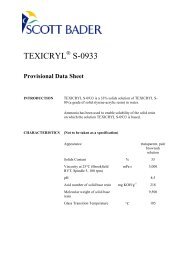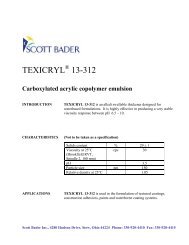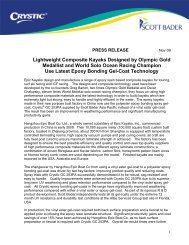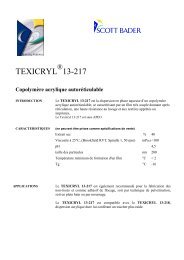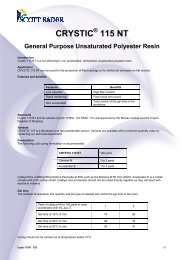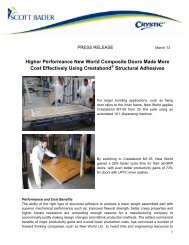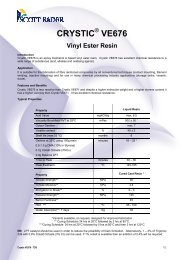Crystic LS 451 PA Resin - Scott Bader
Crystic LS 451 PA Resin - Scott Bader
Crystic LS 451 PA Resin - Scott Bader
- No tags were found...
You also want an ePaper? Increase the reach of your titles
YUMPU automatically turns print PDFs into web optimized ePapers that Google loves.
CRYSTIC ® <strong>LS</strong> <strong>451</strong><strong>PA</strong>Low Styrene ContentPolyester <strong>Resin</strong>Introduction<strong>Crystic</strong> <strong>LS</strong> <strong>451</strong><strong>PA</strong> is a pre-accelerated thixotropic resin suitable for brush or spray application.Applications<strong>Crystic</strong> <strong>LS</strong> <strong>451</strong><strong>PA</strong> is suitable for use in the marine industry and for all general moulding requirements.Features and Benefits<strong>Crystic</strong> <strong>LS</strong> <strong>451</strong><strong>PA</strong> typically contains 25% to 30% styrene. It therefore has a lower styrene emission than standard <strong>LS</strong>Eresins and during the laminating phase, styrene emissions are typically 20% to 30% lower than conventional <strong>LS</strong>E resins.The use of <strong>Crystic</strong> <strong>LS</strong> <strong>451</strong><strong>PA</strong> can significantly reduce the occurrence of print through, to produce mouldings with anenhanced surface finish.Approvals<strong>Crystic</strong> <strong>LS</strong> <strong>451</strong><strong>PA</strong> is approved by Lloyds Register of Shipping for use in the construction of craft under their survey.Formulation<strong>Crystic</strong> <strong>LS</strong> <strong>451</strong><strong>PA</strong> should be allowed to attain workshop temperature (18°C to 20°C) before use. It requires only theaddition of a catalyst to start the curing reaction. The recommended catalyst is Catalyst M (or Butanox M50) whichshould be added at 2% into the resin and thoroughly dispersed, shortly before use. The geltime of the resin can beapproximately determined from the table below:Pot LifeCure System Temperature Pot Life in Minutes2% Catalyst M(Butanox M50)25°C 20The resin, mould and workshop should be at, or above, 15°C before curing is carried out.AdditivesThe addition of certain pigments, ñllers or extra styrene may adversely affect the properties of <strong>Crystic</strong> <strong>LS</strong> <strong>451</strong><strong>PA</strong>. Usersshould seek advice from our Technical Service Department before making any additions.<strong>Crystic</strong> <strong>LS</strong> <strong>451</strong><strong>PA</strong> - TDS 1/3
Typical PropertiesThe following tables give typical properties of <strong>Crystic</strong> <strong>LS</strong> <strong>451</strong><strong>PA</strong> when tested in accordance with BS 2782.PropertyLiquid <strong>Resin</strong>AppearanceBlueViscosity at 25°C 37.35 sec -1 poise 4.0 – 6.0Viscosity at 25°C 4500sec -1 poise 2.0 – 2.4Volatile Content % 30Acid Value Mg KOH/g 20Stability at 20°C months 3Geltime at 25°C using 2% Catalyst M minutes 18 - 22PropertyFully *Cured <strong>Resin</strong>(unfilled casting)Barcol Hardness (Model GYZJ 934-1) 38Deflection Temperature under load † (1.80 MPa)ºC 58Water Absorption 24 hrs at 23ºC mg 14.6Tensile Strength MPa 46Tensile Modulus MPa 2660Elongation at Break % 2.5* Curing Schedule 24 hours at 20°C, 16 hours at 40°C† Curing Schedule 24 hours at 20°C, 16 hours at 40°CPropertyCSM** LaminateGlass Content % 26Tensile StrengthMPa 89Tensile Modulus MPa 6800Elongation at Break % 1.8Flexural Strength MPa 175Flexural Modulus MPa 5700Compressive Strength MPa 161Compressive Modulus MPa 6400** Made with 4 layers 450g/m CSMCuring Schedule 24 hours at 20°C, 16 hours at 40°CPost CuringSatisfactory laminates for many applications can be made from <strong>Crystic</strong> <strong>LS</strong> <strong>451</strong><strong>PA</strong> by curing at workshop temperature(20°C). Some increase in properties may be obtained by post curing. The laminate should be allowed to cure for 24hours at 20°C, and then be oven cured for 16 hours at 40°C or 3 hours at 80°C.<strong>Crystic</strong> <strong>LS</strong> <strong>451</strong><strong>PA</strong> - TDS 2/3
StorageCrystíc <strong>LS</strong> <strong>451</strong><strong>PA</strong> should be stored in the dark in suitable closed containers. It is recommended that the storagetemperature should be less than 20°C where practical, but should not exceed 30°C. Ideally, containers should be openedonly immediately prior to use.Packaging<strong>Crystic</strong> <strong>LS</strong> <strong>451</strong><strong>PA</strong> is supplied in 25kg and 225kg containers.Health and SafetyPlease see separate Material Safety Data Sheet.Version 2 : February 2013All information on this data sheet is based on laboratory testing and is not intended for design purposes. <strong>Scott</strong> <strong>Bader</strong> makes no representations or warranties of anykind concerning this data. Due to variance of storage, handling and application of these materials, <strong>Scott</strong> <strong>Bader</strong> cannot accept liability for results obtained. Themanufacture of materials is the subject of granted patents and patent applications; freedom to operate patented processes is not implied by this publication.SCOTT BADER COM<strong>PA</strong>NY LIMITEDWollaston, Wellingborough, Northamptonshire, NN29 7RLTelephone: +44 (0) 1933 663100Facsimile: +44 (0) 1933 666623www.scottbader.com<strong>Crystic</strong> <strong>LS</strong> <strong>451</strong><strong>PA</strong> - TDS 3/3





